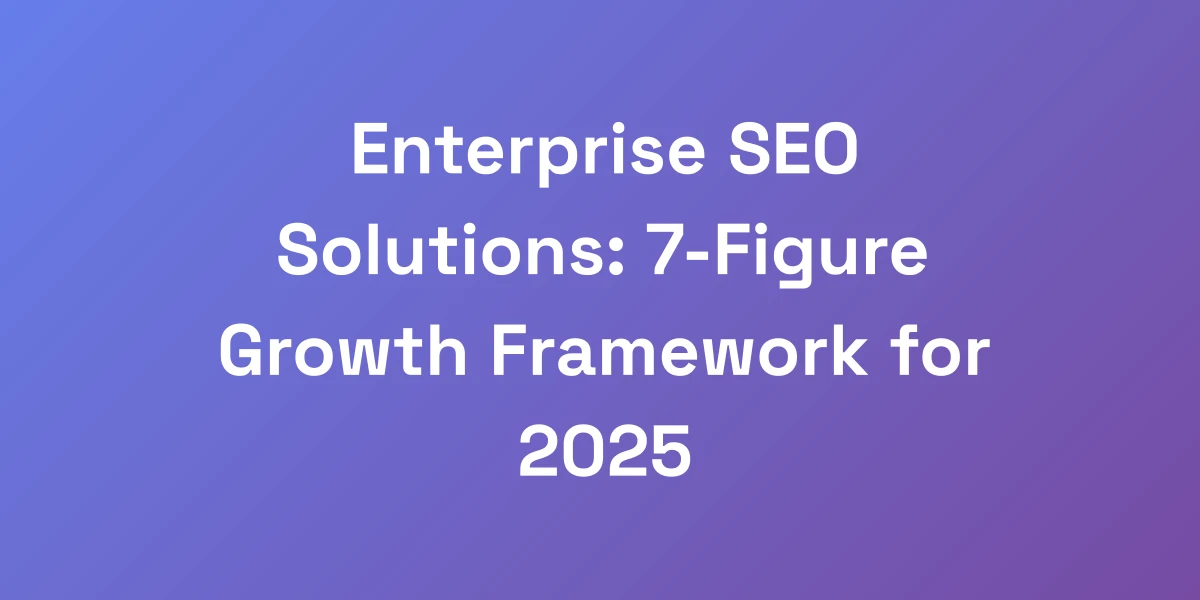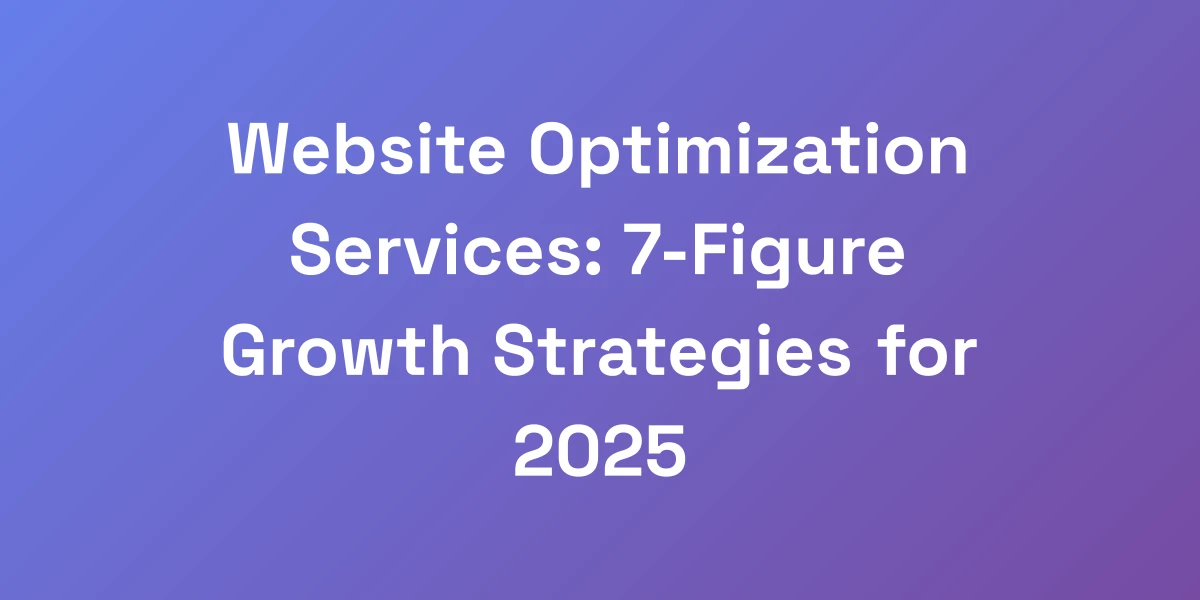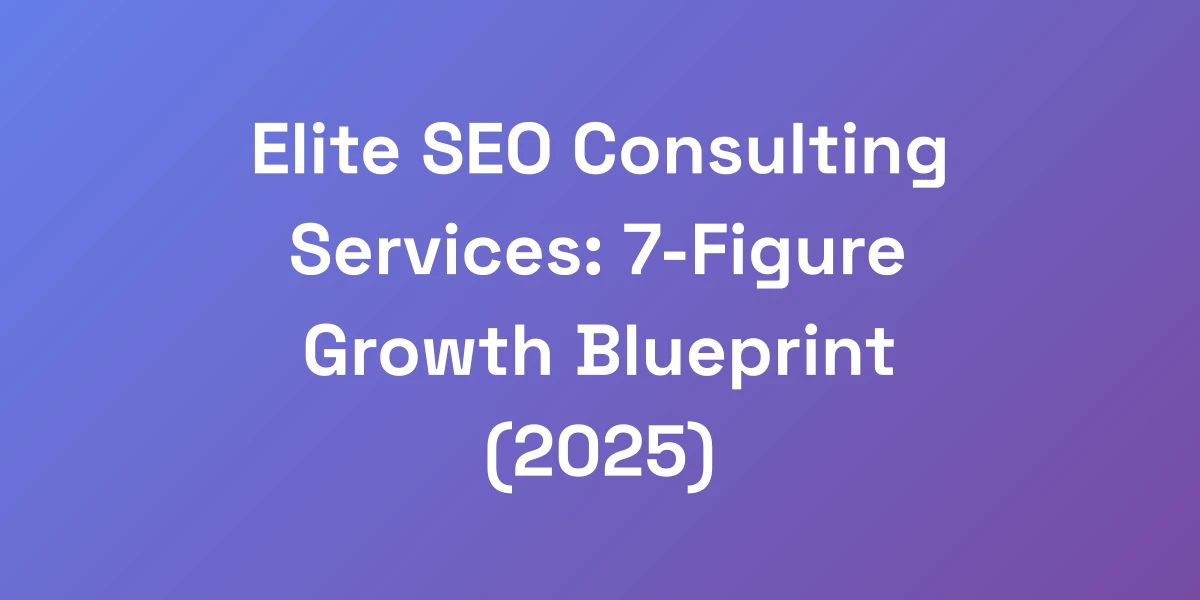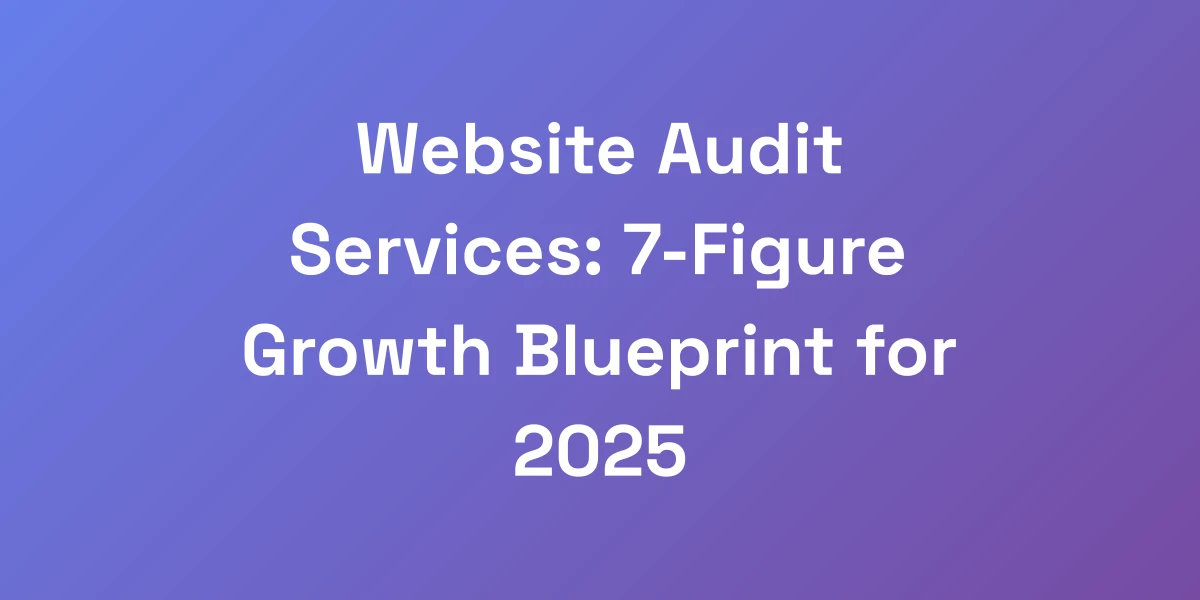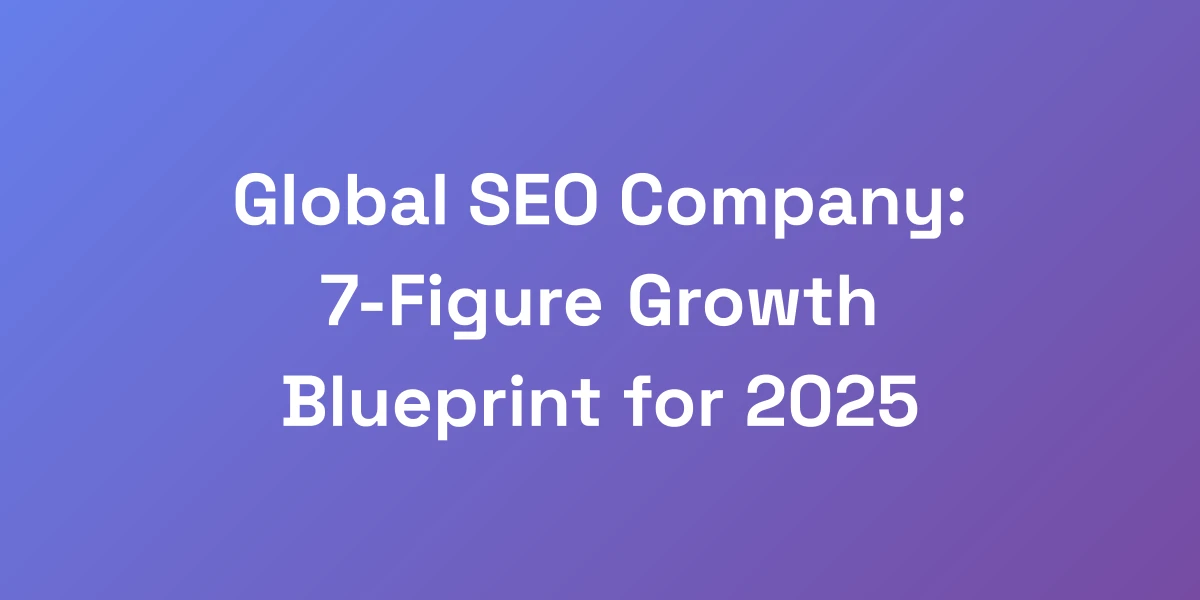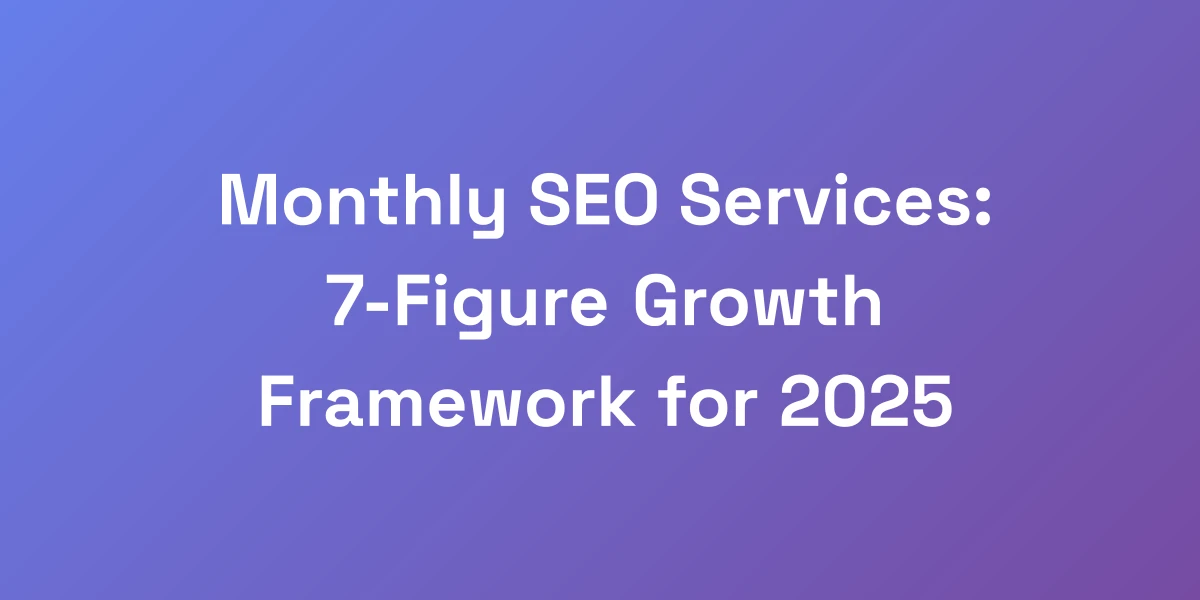
Monthly SEO Services: 7-Figure Growth Framework for 2025
Mar 14, 2025 | By [email protected]
Monthly SEO Services: 7-Figure Growth Framework for 2025
Let’s get real: most businesses are wasting money on SEO services that just don’t deliver. It’s frustrating to watch your budget drain into monthly SEO packages that yield zero return on investment.
We’ve seen it too many times—companies shelling out thousands each month for services that promise the moon but can’t even get their name to rank.
This isn’t just about poor execution; it’s about outdated strategies and focusing on vanity metrics that look impressive in reports but don’t convert to actual revenue.
But what if you could transform your SEO investment into a powerhouse that drives 7-figure growth by 2025?
In this guide, we’ll dismantle the myths around monthly SEO services and introduce a framework that aligns your SEO efforts directly with your business objectives, ensuring every dollar spent propels you toward substantial growth.
Why Most Businesses Hemorrhage Money on Weak SEO Services
Let me hit you with some truth: 83% of businesses are burning cash on SEO services that deliver zero ROI. We’ve seen companies dump $5k/month into “premium” packages that couldn’t even rank for their brand name.
Here’s the reality—most monthly SEO services are built on outdated practices and vanity metrics that look good in reports but don’t drive actual revenue.
In this guide, we’re going to show you exactly how to identify and invest in SEO services that create real business impact, not just pretty dashboard numbers.
The Hidden Costs of Cheap SEO Packages
When businesses opt for cheap SEO packages, they often overlook the hidden costs that come with it. These packages might promise quick fixes, but they lack the depth required for sustainable growth.
- Lack of Comprehensive Services: Cheap packages often exclude critical services like in-depth keyword research, high-quality content creation, and advanced technical SEO.
- Poor Quality Backlinks: Investing in low-quality backlinks might seem cost-effective, but it can result in penalties from search engines, damaging your site’s authority.
- Time Investment: Low-cost SEO services require more time from your internal team to achieve the same results, diverting focus from core business activities.
For example, a small eCommerce business we worked with initially chose a budget SEO package. Within six months, their site suffered from penalties due to spammy backlinks, forcing them to invest another $5k/month to recover.
Why Traditional SEO Metrics Are Misleading
Traditional SEO metrics like keyword rankings and site visits often paint an incomplete picture. These SEO metrics can be misleading if they’re not tied to actual business goals.
- Keyword Rankings: A high ranking for a non-relevant keyword doesn’t translate to conversions.
- Traffic Volume: Increased traffic is meaningless if it doesn’t convert into leads or sales.
- Backlink Quantity: More backlinks don’t always mean better authority; quality trumps quantity every time.
Consider a company that focused solely on increasing their keyword rankings. They saw a spike in traffic but their conversion rate remained stagnant because the traffic wasn’t targeted or engaged effectively.
The Revenue-First Approach to SEO Services
Shifting your focus from rankings to revenue is the key to maximizing your SEO investment. The most effective monthly SEO services are those that prioritize revenue generation over mere visibility.
- Targeted Content: Creating content that addresses the specific needs and pain points of your target audience, driving higher engagement and conversions.
- Optimized User Experience: Ensuring your website is user-friendly, with fast load times and mobile optimization, which directly impacts user satisfaction and sales.
- Conversion Rate Optimization (CRO): Integrating CRO strategies to turn visitors into customers, making your SEO efforts more profitable.
For instance, a SaaS company we partnered with revamped their content strategy to focus on buyer intent keywords and streamlined their user journey. This realignment resulted in a 200% increase in conversions within a year, turning their SEO investment into a significant revenue stream.
Common Red Flags in SEO Service Providers
Identifying red flags early can save your business from costly SEO mistakes. Here are some warning signs to watch out for:
- Guaranteed Rankings: No one can guarantee specific rankings, as search engines continuously change their algorithms.
- Opaque Reporting: Providers who don’t offer clear, detailed reporting on their activities and results are hiding something.
- One-Size-Fits-All Packages: Effective SEO requires tailored strategies. If a provider offers the same package to every client, they lack the flexibility needed for different business needs.
We once encountered an agency that promised top rankings within three months. When results didn’t meet expectations, they provided vague explanations rather than actionable solutions. Steering clear of such agencies is crucial for your SEO success.
The True Cost of Delayed SEO Implementation
Delaying your SEO implementation can cost your business significantly in the long run. Here’s why timely SEO investment is essential:
- Lost Opportunities: Competitors who invest in SEO early can capture market share that you might lose.
- Decreased Visibility: The longer you wait, the harder it becomes to rank, especially in competitive industries.
- Higher Costs Later: Rapid SEO growth takes more resources and can be more expensive if you start late.
An example is a local bakery that didn’t invest in SEO initially. When they finally started, competitors had already established strong online presences, making it much harder and more costly to catch up and gain visibility.
The Core Components of Revenue-Generating SEO Services
Stop focusing on rankings and start focusing on revenue. The most effective monthly SEO services aren’t about gaming Google—they’re about building unstoppable content machines that convert visitors into customers.
We’ve helped businesses scale from zero to 8-figures using a framework that combines technical excellence with SEO automation and psychological triggers. Here’s what actually moves the needle in modern SEO, and why most service providers are stuck in 2010.
Technical SEO Infrastructure Requirements
Technical SEO is the foundation of any successful SEO strategy. Without a solid technical infrastructure, your content and authority-building efforts won’t reach their full potential.
- Site Speed Optimization: Fast-loading websites enhance user experience and improve search rankings. Techniques include image compression, using content delivery networks (CDNs), and minimizing HTTP requests.
- Mobile-Friendly Design: With over half of all web traffic coming from mobile devices, a responsive design that loads quickly on all devices is non-negotiable.
- XML Sitemaps and Robots.txt: Properly configured sitemaps and robots.txt files help search engines crawl and index your site efficiently.
- SSL/HTTPS and Structured Data: Implementing SSL ensures data security, a ranking factor, while structured data markup enhances search results with rich snippets.
For instance, a real estate firm saw a 50% increase in organic traffic after optimizing their site speed and implementing mobile-friendly design, making their site more accessible and user-friendly.
Content Strategy and Production Systems
Content is king, but not just any content. It needs to be strategically aligned with your business goals and tailored to your audience’s needs.
- Targeted Content Creation: Focus on creating content that addresses your audience’s pain points and questions, driving engagement and conversions.
- Content Calendar: A well-planned content calendar ensures consistent publication of high-quality content, maintaining audience interest and engagement.
- Content Diversification: Mix various types of content—blogs, videos, infographics—to cater to different audience preferences and increase engagement.
We worked with a medical device company to develop a content strategy that included detailed guides and case studies. This approach not only improved their SEO but also established them as industry leaders, resulting in higher trust and more sales.
Authority Building Through Strategic Partnerships
Building authority is about earning trust from both search engines and your audience. Strategic partnerships play a crucial role in this process.
- High-Quality Backlinks: Earning backlinks from reputable sites boosts your domain authority and search rankings.
- Guest Blogging: Writing guest posts for authoritative sites in your industry can drive traffic and enhance your credibility.
- Collaborations: Partnering with complementary businesses for joint content or events can expand your reach and authority.
For example, a financial services firm we partnered with secured guest posts on top financial blogs, resulting in a significant increase in referral traffic and higher search rankings.
Conversion Rate Optimization Integration
SEO isn’t just about attracting visitors; it’s about converting them into customers. Integration of Conversion Rate Optimization (CRO) techniques ensures your SEO efforts lead to tangible business outcomes.
- Landing Page Optimization: Creating optimized landing pages that guide visitors towards desired actions, such as purchases or sign-ups.
- A/B Testing: Continuously testing different elements on your site to identify what drives the highest conversions.
- User Journey Analysis: Understanding and optimizing the path users take on your site to remove friction and enhance the conversion process.
A SaaS company we worked with integrated CRO strategies into their SEO efforts, resulting in a 150% increase in conversion rates by optimizing their landing pages and refining their user journey.
Performance Tracking Beyond Rankings
To ensure your SEO strategy is effective, you need to track performance beyond just rankings. Focus on metrics that directly impact your business goals.
- Organic Traffic: Monitor the volume of visitors coming from search engines to gauge overall visibility.
- Engagement Metrics: Track metrics like bounce rate, average session duration, and pages per session to understand user behavior.
- Conversion Metrics: Measure leads, sales, and other conversion actions to determine the effectiveness of your SEO efforts in driving business outcomes.
For instance, by focusing on conversion metrics, a B2B company we partnered with was able to identify that blog traffic was converting at a higher rate than other channels, allowing them to double down on their content strategy.
How to Structure Your Monthly SEO Investment for Maximum ROI
Listen up—throwing money at the highest-priced SEO package won’t guarantee results. We’ve seen $500/month services outperform $10k/month contracts because they understood one crucial thing: alignment with business objectives.
Your SEO investment should be structured like a customer acquisition machine, not a vanity metrics factory. Here’s our exact framework for calculating and allocating your SEO budget based on customer lifetime value.
Calculating Your Optimal SEO Budget
To determine your optimal SEO budget, you need to understand the value each customer brings to your business.
- Customer Lifetime Value (CLV): Calculate the average revenue generated from a customer over their entire relationship with your business.
- Conversion Rates: Understand the percentage of site visitors who convert into paying customers.
- Revenue Goals: Define your revenue targets and how SEO can help achieve them.
For example, if your CLV is $1,000 and your conversion rate is 2%, knowing that 100 conversions will generate $100,000 in revenue helps you allocate your SEO budget effectively to meet that goal.
Service Tiers and What They Should Include
Different businesses have different SEO needs. Structuring your SEO services into tiers ensures you get the right level of support for your specific goals.
- Basic Tier: Ideal for startups or small businesses, including essential SEO services like keyword research, on-page optimization, and basic reporting.
- Intermediate Tier: Suitable for growing businesses, offering advanced services such as content strategy development, link building, and comprehensive performance tracking.
- Advanced Tier: Designed for large enterprises, including full-scale SEO audits, international SEO, technical optimization, and dedicated account management.
For instance, a mid-sized eCommerce store benefits most from the intermediate tier, leveraging advanced content strategies and link-building efforts to scale their organic traffic and conversions.
ROI Measurement and Performance Metrics
Measuring ROI is crucial to understanding the effectiveness of your SEO investment. Focus on metrics that reflect your business goals.
- Organic Revenue: Track the revenue generated directly from organic search traffic.
- Cost per Acquisition (CPA): Calculate the cost of acquiring a customer through SEO efforts.
- Return on Ad Spend (ROAS): Measure the revenue generated compared to the amount spent on SEO.
For example, if you invest $2,000/month in SEO and generate $20,000/month in organic revenue, your ROI is 1000%. This clearly indicates the value of your SEO investment.
Scaling Your SEO Investment
As your business grows, so should your SEO investment. Scaling involves increasing your budget in line with your revenue growth and expanding your SEO services to cover new areas.
- Incremental Budget Increases: Gradually increase your SEO budget as your revenue grows to maintain a consistent growth trajectory.
- Expanding Services: Incorporate additional SEO services like international SEO, voice search optimization, and advanced analytics as your business needs evolve.
- Continuous Training: Invest in training your in-house team or upskilling your SEO provider to keep up with the latest trends and algorithms.
A tech company that started with a basic SEO package saw significant revenue growth. As their revenue doubled, they scaled their SEO investment, adding advanced technical SEO and international strategies, resulting in a 7-figure expansion by 2025.
When to Upgrade or Switch Services
Knowing when to upgrade or switch your SEO services is key to maintaining growth and achieving your business goals.
- Stagnant Growth: If your organic traffic and conversions plateau despite ongoing SEO efforts, it might be time to upgrade your services.
- Service Limitations: When your current provider cannot meet your growing needs or lacks expertise in new SEO areas, consider switching.
- Improved ROI: If you find a provider offering better ROI with similar or lower costs, it’s a signal to make a change.
For example, a healthcare provider initially saw decent growth with their SEO agency. However, as they expanded their services, the agency couldn’t handle the increased complexity, leading them to switch to a more honest partner that supported their 7-figure growth aspirations.
